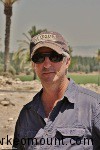We wrote to Professor Eric H Cline, Professor of Classics and Anthropology and Director of the GWU Capitol Archaeological Institute (Columbian College of Arts & Science) whosw “1177 BC” has just been published in Italy
He was so kind to answer’s Arkeomount questions in few days! Here you are the interview (soon will be posted in Italian too).
Arkeomount (A): Dear Professor Eric. H. Cline, you just published “1177 BC” translated in Italian thanks to the Italian editor Bollati Boringhieri. The title identifies a precise date: what happened in that moment and why did you decide to focus the audience to that precise moment of our history?
Eric H. Cline (EHC): That year, 1177 BC, is the eighth year of the Egyptian pharaoh Ramses III. It is also the second time that the Sea Peoples attack Egypt; the first time was thirty years earlier, in 1207 BC. They lose both times and, after 1177 BC, they never come back. Although the collapse of the Late Bronze Age took about a century overall, I chose 1177 BC as the date that best represents the collapse, just as we use AD 476 to represent the fall of the Roman Empire.
A: Something changed in those years. Many empires began to collapse. You did a lot of excavations in the Mediterranean (Israel, Cyprus, Egypt, Greece…) and you collected a lot of data. According to these data what was going on in the XIIth century BC?
EHC: The 12th century BC represents the end of an era — the end of centuries of interconnections and globalization that linked the great empires of the Aegean, Egypt, and the Eastern Mediterranean. Suddenly, just before and after 1200 BC, these regions experienced a wide variety of unfortunate events, ranging from earthquakes to drought and famine to invaders and perhaps even local uprisings.
A: Some authors, as Claudio De Palma (who taught and researched in some US universities as Northern Colorado University and Stanford University), think that these changes pushed Mediterranean people from East to West (he writes about the Arzawa empire), giving life to important cultures as the Etruscan and the Sardinian ones (the “Shardana”). Do you agree?
EHC: This is has always been, and still is, a matter of great debate. I personally think that it is more likely that these changes pushed Mediterranean peoples from West to East, i.e. from Sardinia, Sicily, and Italy to Greece and the Eastern Mediterranean, but there are others who argue as Claudio De Palma does. It is also possible that some went one way, while others went the other, including at different times during this period. We cannot yet definitively decide what is correct.
A: A direct question: who were the Sea peoples? Where do they come from?
EHC: That is the $100,000 question. As I explore in my book, we do not have much actual information about them. All that we really have are the Egyptian inscriptions which mention them by name, including the Peleset, who are probably the Philistines, the Denyen, Weshesh, Shardana, Shekelesh, and so on. There are a total of nine such groups named by the Egyptians, but we honestly do not yet know absolutely where they come from or where they end up, apart from the fact that they attack Egypt and are defeated.
A: From your point of view, what was the passage from Bronze to Iron Age? If we consider the differences between these two metals we must recognize that Iron is very more hardly workable of the bronze, it melts to higher temperatures and its hardness is not great in comparison to that of the well worked bronze, while instead the duration is very inferior. Was this passage a conscious step forward or was it “pushed” because of some “not controlled variable”?
EHC: I think it is most likely that the change to iron was made necessary by decreased access to supplies of both copper and tin towards the end of the Late Bronze Age. We know that iron is already being used in the Late Bronze Age and that bronze is still used in the Iron Age, but it is the frequency of use that changes. It seems to me that one would not make such a change unless it was absolutely necessary, or made sense for other reason, but that seems to have been the case.
A: Let’s talk about approaches to archaeology. Your work is one of the few ones that try to give a “big picture” of what was to world, taking in account a lot of parameters. We support this way of letting people really look at the complexity of history, introducing them to all the variables. This approach needs an open minded vision, ready to collect data from interdisciplinary works. Talking to European and American researchers we feel that the “American way” seems to be more available to collect data from different fields and expertise. Archaeology and anthropology are part of the same department in many American University, while Europe seems to be still fastened to a classical vision that keeps the qualitative and the quantitative data separated. Do you agree? Do you think that this is still “the picture”?
EHC: I’m not sure if this is the “American way” or simply the way that some scholars choose to look at the world. I know of other scholars, from Europe and elsewhere, who also look at the “big picture,” but this is simply the approach that is most interesting to me. With my colleagues, I do publish scholarly studies that are more focused on smaller questions as well, such as on our excavations at Tel Kabri, where we found the oldest and largest wine cellar in the ancient Near East in 2013 (and will be digging the rest of it this coming summer), but when on my own, I do like the “big picture” approach, especially in terms of putting things into context.
A: Thank you very much!
EHC: My pleasure! Thank YOU so much!




